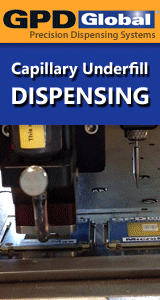William: In answer to your questions:
1 "What do I do about a gold porosity problem?"
Get it fixed, before you go out of business!!! You�ve been yapping about it on the internet for three days now!!! Get a more on!!! I don�t understand your company�s problem resolution process, but I would expect some focal point for solving problems, like Quality Assurance, and would have the following to get the process started:
� A trouble reporting method, like a corrective action request. AND � A team oriented troubleshooting process, like a Material Review Board.
If you don�t have something like that, contact the buyer responsible for purchasing boards and work with him/her on developing an approach.
2 "How would I approach the board house to check for this?"
Again, I�m not sure how your company goes about stuff like this, but I expect it would go something like this:
� I wouldn�t contact the fab directly without release from Purchasing to do so, it�s a nice courtesy. They should be aware of the possibility that you�re going to trash their supplier and/or increase their costs. Odds are, Purchasing will make the first contact with the supplier and get back to you. � Next, Purchasing tells you the supplier will meet with you just after lunch, that�s 2 PM in purchasing agent time, to discuss the problem. � Purchasing and the supplier return from lunch, waddling noticeably. � Purchasing says "I�ll leave you two to get on with this." Which translates from purchasing agent speak to: "Phew, I could use a nap!!!! Bye now." � You take the supplier to the shop and do your A, B comparison thing with the boards. You know, "we took special care to use identical processes on these boards, one from supplier A and the other from supplier B. Yes, same storage, same board age, same paste, same reflow profile, same oven �bla, bla, bla. Now look, the components on board A pop right-off the board, yet the components on board B are firmly attached." And on and on. � Stand back and let the supplier to his/her thing. � Don�t let the slimy little jerk get his/her hands on the good board, because you�ll be killed. First, your other supplier will kill you and drop your company as a customer, and then you�ll have no suppliers, and then the buyer will kill you. � Tell your supplier you need a written root cause analysis and corrective action. And that�s it up to him/her to agree with Purchasing on the plan for that and how the defective product will be handled. � Return the supplier to Purchasing. Of course, knocking first.
3 Does the problem lie in the board house�s chemistry or process?
I don�t know (and what�s more I don�t care, although as you are, I am curious). The fab is responsible for providing boards that are built to spec, according to schedule. How they do that is their business and that�s why they get paid BIG BUCKS. But then again, their children do seem to have a strange far-away look in their eyes and they�re all bald. (Right EM?)
Answer me this:
1 You say, you "see perfect gold thickness." How do you know that? 2 You say, that you see "no phosphorous contamination in nickel bath or after completion of process." How do you know that?
One final note: As someone (I wish I could remember who it was, so I could give him proper credit) said (I�ve taken liberties with the paraphrase) recently: It�s not clear that the benefits of the planar surface of ENIG is worth the hassles of trying to solder to that surface.
Good luck
Dave F
reply »
![]() All,
I am having a problem with joints being soft after SMT...
- Oct 25, 1999
by
All,
I am having a problem with joints being soft after SMT...
- Oct 25, 1999
by
![]()
![]() William: Three things:
1 If the gold is porous, it will n...
- Oct 25, 1999
by
davef
William: Three things:
1 If the gold is porous, it will n...
- Oct 25, 1999
by
davef
![]()
![]()
![]() I am pretty sure I am not having a problem w/porous gold or...
- Oct 25, 1999
by
I am pretty sure I am not having a problem w/porous gold or...
- Oct 25, 1999
by
![]()
![]() William: That your solderability improves with more aggres...
- Oct 25, 1999
by
davef
William: That your solderability improves with more aggres...
- Oct 25, 1999
by
davef
![]()
![]()
![]() Dave,
Last question(s). What do I do about a gold porosity...
- Oct 26, 1999
by
Dave,
Last question(s). What do I do about a gold porosity...
- Oct 26, 1999
by
![]()
![]() William: In answer to your questions:
1 "What do I do abo...
- Oct 26, 1999
by
davef
William: In answer to your questions:
1 "What do I do abo...
- Oct 26, 1999
by
davef
![]()
![]()
![]() Thank you so much Dave for all of your wonderful help. You...
- Nov 01, 1999
by
Thank you so much Dave for all of your wonderful help. You...
- Nov 01, 1999
by
![]()
![]() William: I'm sorry to seem to drill you that was not my in...
- Nov 02, 1999
by
davef
William: I'm sorry to seem to drill you that was not my in...
- Nov 02, 1999
by
davef
![]()
![]()
![]() Hi William,
Can u help me out here. I am new at handling...
- Aug 30, 2002
by
Hi William,
Can u help me out here. I am new at handling...
- Aug 30, 2002
by







